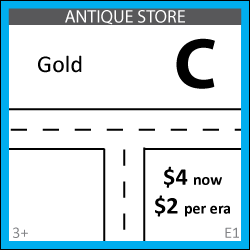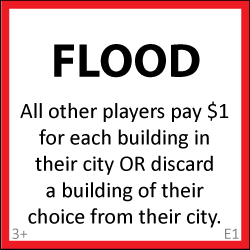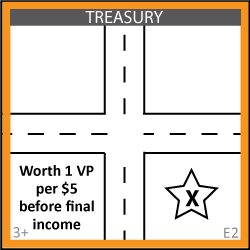building a better drafting game
I've been fascinated by board games that revolve around drafting for years now, and in early 2011 I wrote a post on the pillars that make these games click. Not long after that I started working on a game (then called City Draft) that would be strongly inspired by a few key influences: 7 Wonders for the mechanics and structure, Carcassonne for the idea of placing tiles in a grid, and SimCity for the theme. I touched upon it briefly in an October 2011 post that said it was improving steadily, and I've been working on it off and on (under the name Draftopolis) ever since. I've created an online prototype for playtesting that has seen almost 2000 games completed with at least a dozen players clocking in at over 100 games apiece. The rapid feedback and iteration cycles enabled by this level of playtesting mean that the game is currently in fantastic shape.
I've also had years to mull over the design of Draftopolis, and I wanted to take some time to list out the improvements that I feel it makes over the game that first brought this genre to the forefront: 7 Wonders. Note that 7 Wonders is considered the 17th best board game of all time in the widely respected BoardGameGeek rankings, and I completely agree with that rating. I'm also a huge fan of the designer, Antoine Bauza, who has released several masterpieces of elegant design in the past few years. That said, no game is perfect, and here's a list of some issues I have with the game that I've tried to address:
1. Guilds are based largely on factors outside of your control.
For a variety of reasons, the decks for each age in 7 Wonders are fixed from game to game. The one exception is that each time you play, you randomly select some guilds to shuffle into the Age 3 deck. These guilds mostly provide variable point bonuses based on the types of buildings the players to your left and right have built. This means that finding effective guilds feels largely random since you can't plan your strategy around them and each individual guild is only good if your neighbors happen to be pursuing certain strategies. The best you can do to influence this is to ensure that you have the appropriate resources to play guilds that would be good for you, but even then there's a good chance that a given guild isn't in the deck at all.
 There's a large setup cost to having a selection of cards that are separately randomized at the start of each game, but with a few tweaks I felt that the potential payoff was more than worth it. The simple solution was to move the guilds to the first era (calling them "cornerstone" tiles instead) and to make them dependent on your own strategy rather than those of your neighbors. One example would be the Environmental Agency, which is a Civic building that grants victory points for spaces in your grid that 1) don't have a building and 2) have no nearby pollution. This leads to cities with wide open areas of undeveloped nature that either purchase all of their goods from other players or carefully position their industry in a corner surrounded by their other buildings. With 30 different cornerstone tiles that could show up, successive games of Draftopolis feel very different from start to finish.
There's a large setup cost to having a selection of cards that are separately randomized at the start of each game, but with a few tweaks I felt that the potential payoff was more than worth it. The simple solution was to move the guilds to the first era (calling them "cornerstone" tiles instead) and to make them dependent on your own strategy rather than those of your neighbors. One example would be the Environmental Agency, which is a Civic building that grants victory points for spaces in your grid that 1) don't have a building and 2) have no nearby pollution. This leads to cities with wide open areas of undeveloped nature that either purchase all of their goods from other players or carefully position their industry in a corner surrounded by their other buildings. With 30 different cornerstone tiles that could show up, successive games of Draftopolis feel very different from start to finish.
2. Science is purely all or nothing.
One of the core qualities of a solid drafting game is that players value the same cards significantly differently based on their position. In 7 Wonders, this manifests to an extreme with Science, which is nearly useless unless you commit heavily to it. Often you find yourself in a position where the player behind you is picking up Science cards and the game comes down to whether you're willing to spend early picks hate drafting them (torpedoing both your chances) or whether you let them through, nearly guaranteeing their victory. And if you choose the latter option, everyone at the table blames you for letting them win.
 In Draftopolis the role of Science is filled by Residential tiles, which are worth increasing numbers of bonus points when they're placed contiguously into neighborhoods. The key difference is that I later stumbled onto the idea of including a thematically appropriate rule (called the "Ghost Town" penalty) that states that cities without any Residential tiles lose 10 points, and cities with only one lose 4 points. With this, all players have a large incentive to at least dabble in Residential and competition is ensured for the high value tiles within that category. In addition, the bonus flattens out after the eighth Residential in a neighborhood (rather than continuing to grow exponentially) so that even a player who gets all of the Residential tiles still needs to earn points in other categories to win the game.
In Draftopolis the role of Science is filled by Residential tiles, which are worth increasing numbers of bonus points when they're placed contiguously into neighborhoods. The key difference is that I later stumbled onto the idea of including a thematically appropriate rule (called the "Ghost Town" penalty) that states that cities without any Residential tiles lose 10 points, and cities with only one lose 4 points. With this, all players have a large incentive to at least dabble in Residential and competition is ensured for the high value tiles within that category. In addition, the bonus flattens out after the eighth Residential in a neighborhood (rather than continuing to grow exponentially) so that even a player who gets all of the Residential tiles still needs to earn points in other categories to win the game.
3. Few viable paths to victory.
In the base set of 7 Wonders, there are only a few strategies that can consistently win games: mainly heavy Science (when it's underdrafted), Military (with pacifist neighbors), or resource heavy (leading into some high value Civic buildings). The Commercial (yellow) strategy has a tough time winning due to the poor exchange rate of money to victory points (3 to 1) and heavy Civic (blue) strategies simply can't compete with other plans that end up earning points more efficiently. That said, the Leaders expansion does a wonderful job of fixing this problem without adding significant amounts of complexity.
 Draftopolis utilizes the cornerstone tiles and more favorable point conversions for money strategies (1 VP for each $2, with players capable of ending games well over $100) to open up the playing field. Residential-focused, Commercial-focused, and Industrial-focused strategies are all viable, as well as hybrid builds revolving around efficient tiles and/or one or more cornerstones. This display of the recent winning cities shows off the relative diversity of strategies that can do well.
Draftopolis utilizes the cornerstone tiles and more favorable point conversions for money strategies (1 VP for each $2, with players capable of ending games well over $100) to open up the playing field. Residential-focused, Commercial-focused, and Industrial-focused strategies are all viable, as well as hybrid builds revolving around efficient tiles and/or one or more cornerstones. This display of the recent winning cities shows off the relative diversity of strategies that can do well.
4. Limited play decisions.
After a card is picked in 7 Wonders, there are only three choices of what to do with it: play it, build a stage of your wonder, or sell it. As the wonder option is often unavailable due to resource constraints, and selling is rarely worthwhile, this leaves only one real choice most of the time.
 By contrast, Draftopolis features a 5x5 city grid that each player is independently filling with their tiles, with available trade routes on either side that provide benefits when a road is connected to them. The choice of where to play early tiles can play a crucial role in how a city develops into the mid and late game. A key decision that I settled on early in the process was that tiles can't be rotated, as the combinatorial possibilities of tiles, placements, and orientations would result in analysis paralysis for a lot of players. I do feel that the placement decision layer adds significant skill to the game, and it does so without adding too much time since everyone decides where to put their tiles simultaneously.
By contrast, Draftopolis features a 5x5 city grid that each player is independently filling with their tiles, with available trade routes on either side that provide benefits when a road is connected to them. The choice of where to play early tiles can play a crucial role in how a city develops into the mid and late game. A key decision that I settled on early in the process was that tiles can't be rotated, as the combinatorial possibilities of tiles, placements, and orientations would result in analysis paralysis for a lot of players. I do feel that the placement decision layer adds significant skill to the game, and it does so without adding too much time since everyone decides where to put their tiles simultaneously.
5. Static sell values and trade costs.
In 7 Wonders, cards in later ages are significantly more powerful and valuable than early age cards. Yet the return for selling a card remains $3 throughout, and selling a card in the third era (for the equivalent of 1 VP) is an almost surefire way to lose the game. Similarly, the cost for purchasing a resource is always $3, which is a massive commitment early game and a relatively small pittance late.
Draftopolis scales both the trade cost and the sell price throughout the game, increasing by $1 per era. This softens the "noob trap" elements of the sell option, and commodity-focused strategies are more rewarding since each sale will bring in the equivalent of 2.5 victory points in the final era.
EDIT: After playtesting this rule some more, I've changed the design to use a $5 static sell value and trade costs that only depend on the tier of the commodity being sold. Both of these values can be listed directly on the playmat and players don't have to go through an additional step to calculate the cost or benefit of a potential trade or sale.
6. Players can only interact with their direct neighbors.
Being sandwiched between two resource light players in 7 Wonders can be devastating, as many buildings and wonders require multiples of a single resource in their cost. Situations where you know that someone across the table is running away with the game without any way to affect them can also be frustrating.
 For Draftopolis, I originally allowed players to purchase resources directly from the bank at a steeper cost, but this added complexity and created awkward decision points where you had to decide whether it was worth it to pay extra to avoid helping out your neighbor. I eventually settled on a replacement solution of allowing resources to be purchased from anyone at the table with a $1 transport fee for each player between the seller and buyer. If a commodity such as Steel isn't being produced yet, then everyone is in the same boat of being unable to play tiles that require it. In addition, disaster tiles give players a way to affect players across the table, without introducing direct attacks or other mechanics that would call for political posturing.
For Draftopolis, I originally allowed players to purchase resources directly from the bank at a steeper cost, but this added complexity and created awkward decision points where you had to decide whether it was worth it to pay extra to avoid helping out your neighbor. I eventually settled on a replacement solution of allowing resources to be purchased from anyone at the table with a $1 transport fee for each player between the seller and buyer. If a commodity such as Steel isn't being produced yet, then everyone is in the same boat of being unable to play tiles that require it. In addition, disaster tiles give players a way to affect players across the table, without introducing direct attacks or other mechanics that would call for political posturing.
7. Militaristic neighbors can further invalidate strategies.
When a player wins with the military strategy in 7 Wonders, it's often because one or both of their neighbors chose to eschew building red cards at all, letting them get maximum military points with a very small investment. On the other hand, neighbors who are willing to fight for military superiority put a player into a decidedly worse position pretty much from the get-go.
Draftopolis allows full control over trade routes (by making it a permanent feature of the game board rather than a card that must be drafted) as well as the cross-table resource purchasing, so players have the tools to react to any situation that their neighbors might create for them. Sometimes trade routes will be hugely valuable, and sometimes it's better to cluster one's buildings to make them easier to protect with Fire or Police Departments. Complaints about table position have been few and far between in my experience.
8. The pass direction is inconsistent.
When I watch new players try out 7 Wonders, the number one rule I see them mess up is the swapping of the pass order in the second era. Even experienced players often forget which way the cards are being passed, which can slow down the game or cause issues with the packs as they travel around the table.
I originally had cards being passed the opposite way in the second era in Draftopolis, but eventually came to the conclusion that always passing left is simply better for the game. It's easy to remember and makes it clear which neighbor you should be paying attention to when settling on a plan. In games where you play your drafted cards immediately, you have perfect information about what strategies your neighbors are pursuing, and therefore you can always make an informed decision.
9. More players mostly just means more copies of the same cards.
This does ensure that you're playing the "same game" when there are more or fewer people, but it's also boring, and it relates directly to the next most common rules mistake that I've seen: people playing second copies of the same card. Double checking that each card you want to play doesn't have the same name as a card you already have is both time consuming and not particularly fun.
 In Draftopolis, every tile is unique, and each additional player results in new possibilities and potential city configurations. There also aren't any rules that prevent the selection of a tile because of tiles already present in a city. Games with different numbers of players each have their own unique flavor, and certain strategies are slightly stronger or weaker depending on the number, further increasing the replayability of the game. For example, the Treasury is only available with five or more players, and it enables a strategy focusing on Commercial buildings that produce lots of upfront cash as opposed to a more traditional build favoring high income tiles.
In Draftopolis, every tile is unique, and each additional player results in new possibilities and potential city configurations. There also aren't any rules that prevent the selection of a tile because of tiles already present in a city. Games with different numbers of players each have their own unique flavor, and certain strategies are slightly stronger or weaker depending on the number, further increasing the replayability of the game. For example, the Treasury is only available with five or more players, and it enables a strategy focusing on Commercial buildings that produce lots of upfront cash as opposed to a more traditional build favoring high income tiles.
10. With 6+ players, you never see the same pack twice.
Last but not least, with six or more players in 7 Wonders, you'll never see the packs that you open ever again. And with seven players, there will be packs opened next to you that never make it to you even once. This cuts out a significant aspect of drafting strategy ("tabling" cards) and contributes strongly to the perception that there's nothing you can do about someone across the table who's doing well.
Of course, this problem is easy to "solve" by just adding tons of cards (or tiles) to each pack, but that comes with its own set of problems: choices being overwhelming, the play space getting too crowded, etc. For these reasons I started testing Draftopolis also with seven tiles per pack, but I soon settled on the sweet spot being eight. Any more and it starts getting difficult to fan them out in your hand, any fewer and you start losing the "tabling" aspect as mentioned above. With the maximum number of players (six) you still get a second tile out of each of your opening packs, and with three players you even get a third.
In conclusion...
Draftopolis is a game that borrows heavily from 7 Wonders in many respects while simultaneously attempting to strike out in a bold new direction. It plays quickly but has far reaching depth, and after hundreds of games I still find myself agonizing over turns with regularity. I'm also starting to think seriously about looking for a publisher, so hopefully you'll be able to play a tabletop version of the game sometime within a year or two. Thanks for reading and I'd love to hear other takes on both 7 Wonders and my proposed solutions in the comments!
November 4th, 2015 - 05:05
Just wanted to say that I bookmarked this blog three years ago and forgot about it. Coming back to it just now, I read nearly the whole thing in one night. Thanks for writing!
February 23rd, 2016 - 23:35
No problem, glad you enjoyed reading through it. Hopefully I’ll find some time to write again soon!
May 25th, 2021 - 01:56
Thank You!
– become a game developer.
August 20th, 2022 - 03:15
PUBG MOBILE MOD Apk – One of the most popular survival games on the gaming market and has undergone a revolutionary change is PUBG MOBILE. Players will spend time exploring futuristic elements and experience a beautiful yet equally challenging world. In addition, you will be able to access new equipment in regions or be pre-equipped by players to survive longer in the harsh world.